Categories
Latest Updates
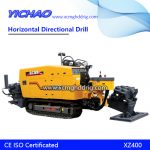
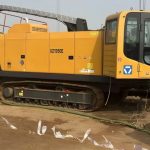
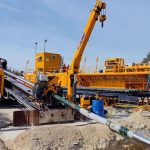
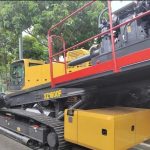
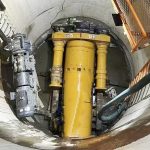
Equipment in place
Determine the crossing route
Measuring payoff
Preparation before construction
Reaming
Traction pipe crossing
Pipe welding
Guided drilling
Mud wall
Backfilling
Pipe welding
Pressure flushing
Two pipe pits, the main pit auxiliary pit, the size is 5 meters long × 8 meters wide × 3.5 meters deep, the support method is steel sheet pile support, 5 steel sheets piled per meter, horizontal steel sheet pile Model 40B, 12 meters long. The depth of the work pit is planned to be buried 9 meters deep. In order to ensure the drying and reaming construction in the working pit, a mud sedimentation tank is arranged on the south side of the working pit, and a mud pump is arranged at the bottom of the tank to take the excess mud out of the pit at any time.
Place the rig according to the actual situation on site. Because the soil at the pit is soft, and the distance between the pipe is long, the pulling force is large. The bottom of the rig should be placed on a 20cm thick C15 concrete flat base, and ∮20 steel bar (ground anchor) and rig welding should be reserved in the flat base concrete. Tight to prevent foundation settlement from affecting the stability of the rig.
The good and bad drilling fluid plays a crucial role in the success of the pipe construction. The drilling fluid has a cooling drill bit, a lubricating drill, and more importantly, can suspend and carry the cuttings, so that the mixed cuttings become flowing mud and smoothly drain out of the hole, which provides sufficient annular space for the returning pipeline, and Reduce the weight and resistance of the return line. The mud remaining in the pores can function as a retaining wall.
The geological exploration data of this project has not been given yet. It is only possible to configure the drilling fluid according to the previous construction experience and understanding of the geological conditions in similar areas. The drilling fluid consists of water, bentonite and polymer. Water is the main component of drilling fluids, and bentonites and polymers are often referred to as drilling fluid additives. The better the quality of the drilling fluid and the more appropriate the mixing with the cuttings, the better the fluidity and suspensibility of the produced mud, and the better the effect of re-expansion into the hole, the greater the probability of success.
In order to improve mud performance, it is sometimes necessary to add an appropriate amount of chemical treatment agent. Caustic soda (or soda ash) can increase viscosity, increase static shear force, and adjust PH value. The amount of caustic soda is generally 2% of the amount of bentonite.
According to the above theory, the drilling fluid mixing ratio of the project is determined as: bentonite 20%, transfer liquid 1%, water 75%, 2% bentonite weight caustic soda.
After the rig is in place, adjust the rig’s guide bar to a position slightly above the center of the design tube position and drill horizontally into the soil. The transmitter is installed in the guiding drill bit, and the parameters such as the depth of the drill bit, the angle of the duckbill board, the drilling apex angle, the bit temperature and the battery condition are measured through the ground receiver, and the measured parameters are compared with the drilling trajectory. In order to correct in time. The ground receiver has a display and transmission function, and wirelessly transmits the received bottom information to the receiver of the drilling machine, and the operator displays the drill according to the signal feedback to drill in the correct trajectory. During the guided drilling process, the technician judges the deviation of the position of the guide head from the drilling route map according to the signal sent back by the detector, and adjusts at any time. And record the adjustment value in the corresponding table of “Drilling Position”.
In order to ensure that the guide head can proceed in strict accordance with the instructions issued by the operator, it is necessary to encrypt and fine-tune the control points after the initial route of the pipeline. The middle line and elevation control points are set at intervals of 3m, and the wooden piles are used to make obvious signs, and the concrete piers are built around the pile points to protect them. The controller strictly controls the instrument according to the point.
According to the previous construction experience, the pipeline sinks in the process of pulling the pipeline in the process of gravity. Therefore, in this project, the drilling point for guiding drilling is selected slightly higher than the center line of the design pipe. To reduce the impact of the pipe’s own weight on the elevation.
According to the geological conditions of the site, a scraper reamer is used. The size of the reamer is 1.2 to 1.5 times the diameter of the pipe, which keeps the mud flowing smoothly and ensures the safe and smooth entry of the pipeline into the hole.

The distance between the reaming and reaming pipe is relatively long, and the mud effect is particularly important. The lack of mud in the hole will cause accidents such as collapse and cause the guiding drilling to lose its function and bury the hidden danger for re-drilling. Considering that the formation mud is more likely to be lost, after the mud is lost, the mud is lacking in the hole, and the friction between the drill pipe and the pipeline and the hole wall is increased, resulting in an increase in tensile force. Therefore, it is necessary to maintain “re-slurry” throughout the drilling process, and adjust the drilling fluid ratio to produce different muds in time according to changes in geological conditions.
During the construction, water, bentonite, polymer, etc. are added to the mixing chamber, and the mixture is thoroughly stirred to form a drilling fluid. The drilling fluid is then pumped through the hollow drill pipe to the bottom hole drill by the drilling fluid pump and mixed with the drill cuttings in the hole to form a slurry flowing at the bottom of the hole. Since the working pit is located upstream of the pipeline, although the horizontal drilling is reaming, the mud in the downstream of the hole will not be lost too much. When reaming, only the mud in the 2# pit mud pool needs to be replenished into the hole at any time through the drilling pumping system. The experimenter needs to check the proportion of each component in the mud at any time and adjust it in time, and recycle it repeatedly.
After the pipeline strength test is passed, the pipe construction can be entered. Firstly, the pipe head is sealed by the “steel pipe sleeve” made in the field, then the head is connected back to the back end of the pipe head, and the pipe is connected with the transfer case to take over the pipe. After the pipe is returned to the working well, the pipe head is unloaded. , the transfer case, take out the remaining drill pipe, plug the plugging head, and carry out the water pressure test.
During construction, the operator of the pipe drawing machine should draw the pipe evenly and smoothly according to the equipment data, and must not pull hard.
After the pipe is pulled in, in order to avoid ground subsidence, grouting reinforcement is required. Due to the constraints of the site conditions, this time the reinforcement measures for grouting in the hole were adopted.
(1)Before the construction of the pipe, two steel pipes of the same length as the pipe are connected at the front end of the pipe, and the pipe is pulled into the soil together with the pipe and reaches the end point of the design of the pipe. After reaching the end point, the connection between the ∮25 steel pipe and the pipe is released, and a 6m long grouting flower tube of the same diameter is added in front of the two steel pipes.
(2)Move the pipe puller to the receiving pit, connect it to the ∮25 steel pipe and look back. For every 6m, the connection between the steel pipe and the pipe drawing machine is canceled and replaced with a high pressure grouting pump. Inject 1:1 cement and fly ash slurry (0.4Mpa) to replace the thixotropic mud and replenish the void around the tube. Then change and pull again, then pull and re-note, repeat. Until the steel pipe is pulled out of the 1# receiving pit, the grouting process is all over.
Pay attention to the grouting construction:
Due to the complex geological conditions and long distances during construction, necessary safety protection measures must be set during construction, mainly including:
(1)Anti-electric shock alarm system, once the underground drill bit touches the charged body such as cable, the rig will give an electric shock alarm. At this time, the operator must sit on the seat and must not leave to avoid electric shock. The operator can leave the rig after the alarm is removed.
(2)Long-distance remote emergency stop device, while drilling and tracking, the measure should always keep in touch with the rig operator, and should be disposed of in time if an accident occurs. At present, wireless communication is generally used, and sometimes it is impossible to cope with an emergency due to the influence of the local environment at that time. Therefore, during the construction, the drilling follower should use emergency measures to stop the drilling rig. After the treatment is completed, the latter can lift the drilling rig after releasing the restriction on the drilling rig.
